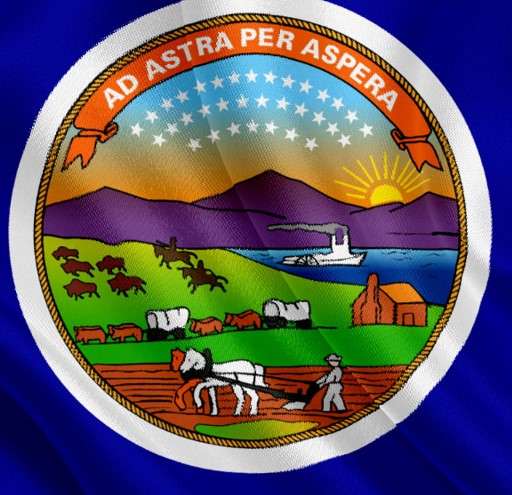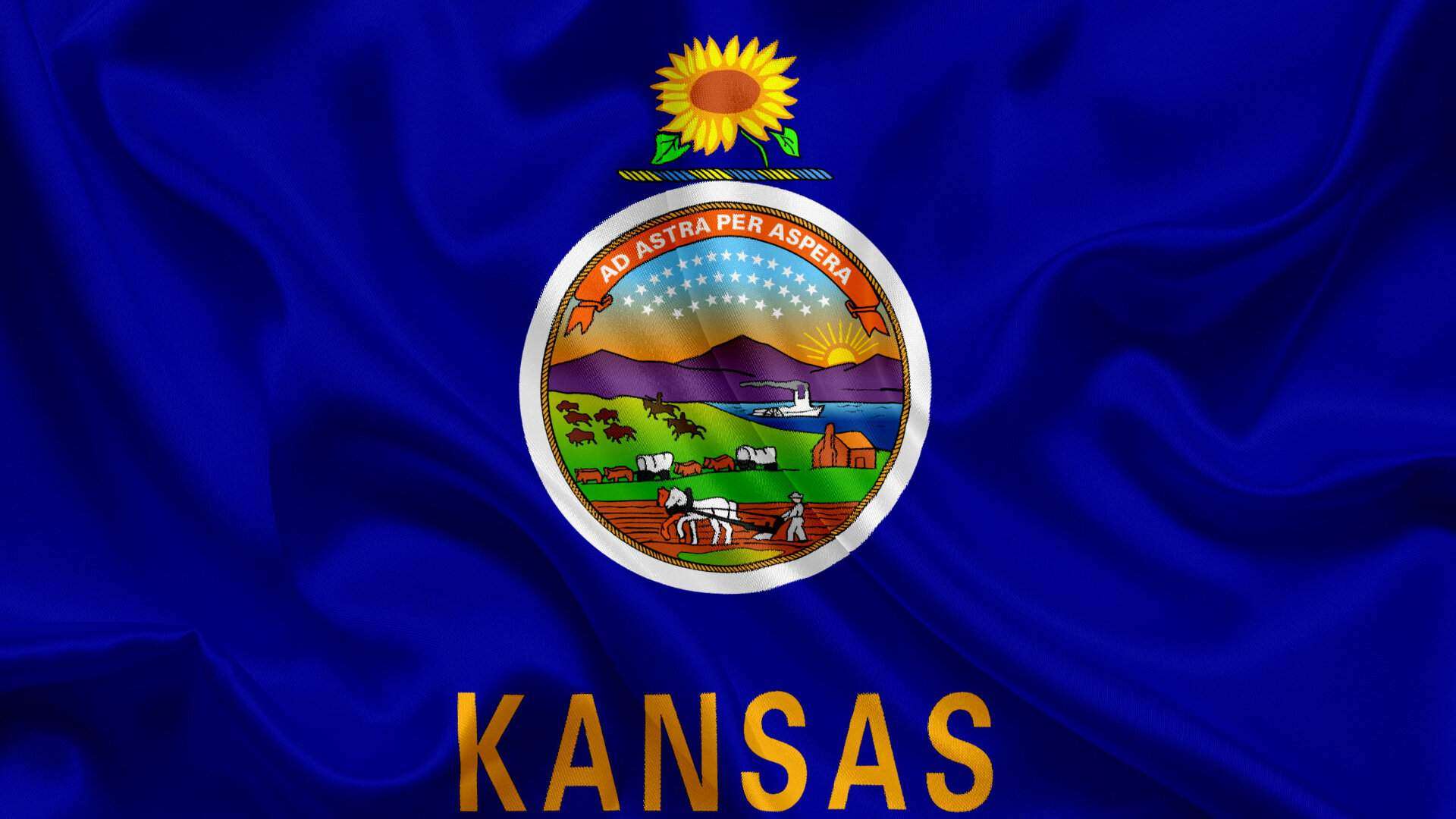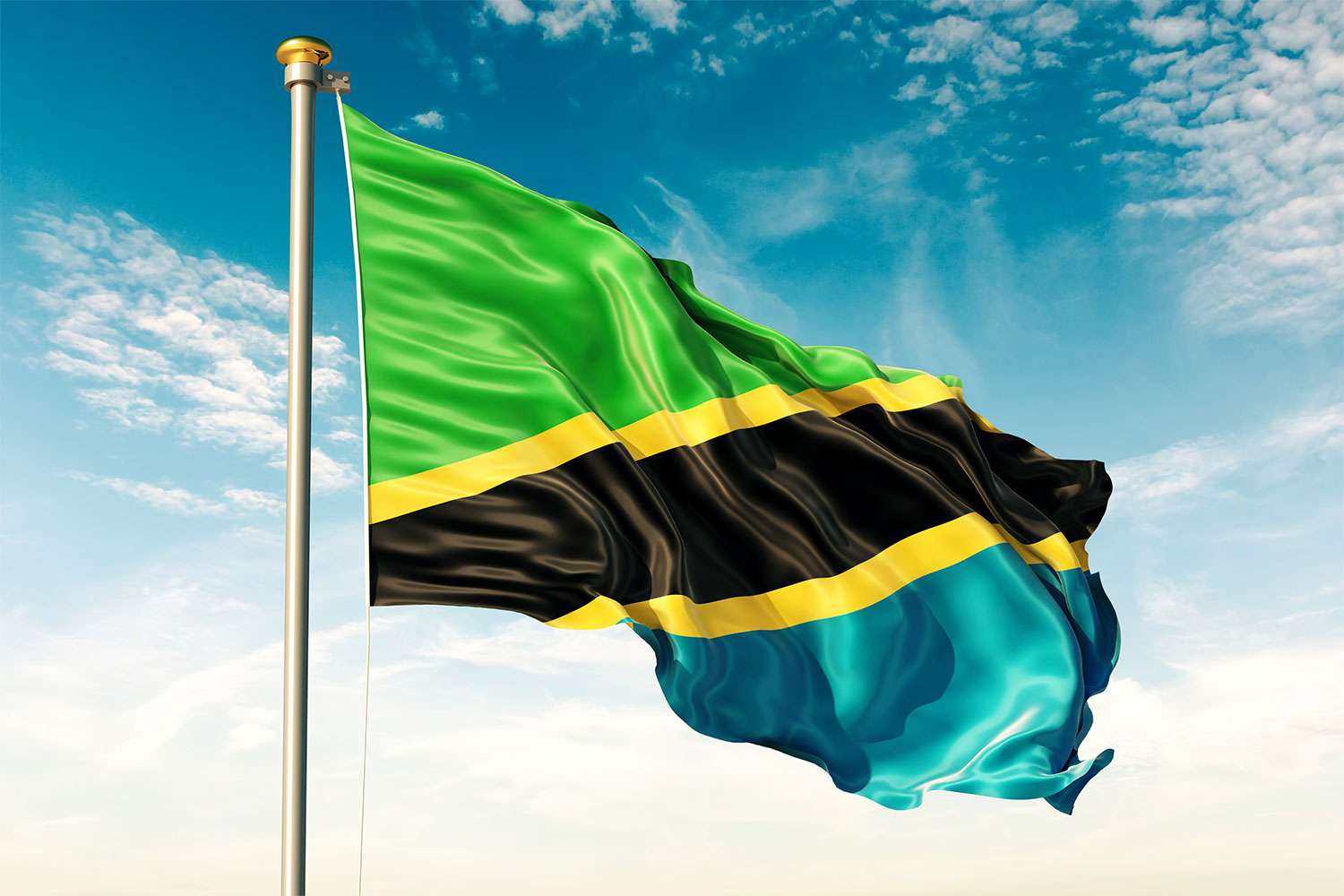
Hazel Avery designed the Kansas flag in 1925, and it was first carried in a Fourth of July parade in Lincoln, Kansas. On official events, the state was usually presented by the flag it established on March 23, 1927. The Kansas flag is a rectangle of dark-blue silk with the state seal in the centre. It was first flown at Fort Riley by Governor Ben Paulin for the Kansas National Guard and the Fort Riley army personnel. In 1927, the Kansas Legislature designated it as the official state flag. The state crest, a sunflower perched on a twisted bar of blue and gold, is displayed above the seal. Below the seal is the 1961 addition of the word “Kansas” in block gold letters.
In place of a flag from 1925 to 1927, Kansas adopted a state banner. The Kansas flag, a huge sunflower with the word “Kansas” on a blue background, was designed to be hung from a horizontal bar as opposed to a vertical flag pole. To minimise “competition” with the American flag, it was given a special design. There have been complaints that this flag is difficult to distinguish because it is designed so similarly to the flags of many other states. Thus, underneath the seal in broad golden letters, the state’s name was added in 1961.
Usually, the state flag is flown alongside the American flag. The American flag is always displayed higher or in a position of greater reverence. The state flag is displayed next, followed by any city or society flags. The state flag should be displayed alongside the American flag in size equivalence or smaller.
Why Kansas Flag was at Half Mast Recently
In concordance with Executive Order 20-30, Governor Laura Kelly ordered flags throughout Kansas to be flown at half-staff on all state buildings, grounds, and facilities from sunrise on Wednesday, December 7, 2022, to sunset on Thursday, December 8, 2022, recognising the National Pearl Harbor Remembrance Day on its 81st anniversary.
About the Kansas State Seal

The Kansas State Seal, sitting at the centre of the Kansas flag, is replete with symbolism, chosen with an eye to recognise some key natural and anthropic heritages as the pillars of the State’s expression of formal identity.
Eastern Symbolism
Kansas was indebted to the East for its establishment. As a supreme sign of the direction, the rising Sun, peeking over the rolling hills was chosen. The nascent rays betokening the expressive delight and adventurous zeal of a new beginning of a newly formed identity.
Native American Symbolism
Beyond that, there rests the image of a train of ox-wagons going West- a subtle poetic reference to the pioneering of Kansas. It was the Westward expansion which brought the settlers to the place in the first instance.
Moving away from this image, one would notice, in the background, a herd of buffalos, in retreat, in a pursuit by two Native Americans on horseback. Native Americans and the bison were given the merit of being recognized as an indispensable heritage of the state. As non-native peoples or the European whites grew more abundantly in the Eastern part of the United States, institutional mechanisms were formed to move Indian tribes farther west.
As early as 1803, President Thomas Jefferson delivered a plan that directed eastern tribes land west of the Mississippi River. In 1825 and 1830, however, Congress passed targeted acts that forced removal of the Native American peoples.
In 1829, the Delawares were the first Native Americans to sign a treaty giving them land in what was to become Kansas. Following 1830, close to 30 tribes were allocated in the region. This inclusion of the Native American in the seal is not an irrelevant historical appendage and memorandum, because these peoples are ingrained in the identity of Kansas. Native American tribes such as Arapaho, Cheyenne, Comanche, Kansa, Kiowa, Osage, Pawnee, are considered native to present day Kansas. Today, Kansas harbours four Indian reservations–the Iowa, Kickapoo, Potawatomi, and Sac and Fox. American Indians of various tribal identities reside in the cities and towns of the state. Despite the continued existence of cultural distinction, the traditional norms and mores have changed over time resulting in a medley of mixed traditions and new collective identities.
Incidentally, The American Buffalo, staples of the prairie, still make up received the recognition of being the official animal symbol of the state of Kansas in 1955 and thus the symbolism still carries force with regard to its relevance in contemporary Kansas life.
Commercial Symbolism
Moving our eyes further, we stumble upon a depiction of commerce beside and along a river and we also notice the image of a steamboat. This is a rich commemoration of the fact of rivers such as the Kansas and the Missouri as the life – bearing commercial veins of the contemporary state of Kansas.
Agricultural Symbolism
Agriculture has always played a pivotal role in the economic life of the state of Kansas. According to www.kansascommerce.gov, it has more than 45 million acres of farmland, and tops the production of wheat and sorghum in the US according to NAAS 2020 rankings and they lead the production of cattle, sunflowers, bison, hogs and soybeans. On consultation with the official website of Kansas Historical Society, a state agency charged to preserve and share the state’s history, the best of seeds were preserved and buried near homes subsequent to collection and consumption of wild plants, alongside the practice of hunting for game and thus the process of farming saw its inception. Therefore, we shall be remiss to escape the foundational compound image of a settler’s cabin and that of a man ploughing with a pair of steeds as a socio-cultural cornerstone of the state’s identity and legacy, formalised into the seal.
Mountain Symbolism and More History of The Seal
On a scrutiny of the background, we see the depiction of a rolling mountain. Although fertile ground for equivocal conjectures and speculations, the practical possibility behind the incorporation of the image seems to suggest the undulating terrain of Fort Riley of present times. The conceptualization of this particular naturalistic imagery owes itself to John H McDowell who took a guiding role, along with John J. Ingalls in the formation of the State Seal in 1861, when Governor Charles Robinson brought public stress on the formation of the State Seal and the matter was being labored in committees both in the State House and the State Senate.
History Of The State Motto
Before its incorporation as a State on 29th January, 1861, Kansas was an area of intense turmoil on the issue of slavery. Despite the fact that most settlers were either anti-slavery or abolitionists, there was a powerful horde of Missourians, just on the other side of the lines, vouching in favor of slavery. As an escalation of the debacle of fraudulent casting of votes from Missourians an episode of horrific violence swept over Kansas, which would await its closure deep into the Civil War. The horrors and atrocities of both sides earned the place the title of “Bleeding Kansas” and the communal trauma worsened the laboring pain of the birth of the state. The memory of the struggle of the anti-slavery faction and their aggrieved but ultimate victory was commemorated by the lofty spirit of the motto suggested by Ingalls, “Ad astra per aspera” (“To the stars through difficulties”).
34 Stars of Kansas Flag
In an almost natural flow one takes a sombre note of the cluster of 34 stars in the Kansas flag, heralding the inclusion of Kansas as the 34th state into the Union on the 29th January, 1861, roughly a couple of months before the ripples of the first shots of Civil War would foreshadow the imminent torment destined to set the character of the land of the brave and the home of the free.
Physical Specifications
We must now broaden our view and look at the contours of the Kansas flag. Within the playing field defined by 3 fts. of length and 5.1 fts. of breadth, it interfaces the viewer with an azure background with other colors (blue, orange, brown, green, and white) sketching the front. We can see a Sunflower, severed from its stalk, resting with the languish of glorious decay, on a twisted bar of blue and gold.
Symbolism of The Bars
The bars hark back to how the state was fashioned out of the famous Louisiana Purchase where a settlement was achieved between the French First Republic and the United States effecting the exclusive authority of the latter to gain land either through contract or conquest from the indigenous people of the soil.
The Sunflower Story and Letters of Gold
A pertinent anecdote states how statesman George Morehouse became aware of the citizenry wearing these sunflowers at out-of-state events for representational purposes and this, along with the natural abundance of sunflowers paved the way to its being the official flower symbol in 1903. The torn sunflower then readily suggests to the reflective speculator its symbolic importance. It’s the declaration of Kansas’s unyielding passion for holding onto the purity of its essence through hardships- fulfilling the spirit of the letters- KANSAS written in gold.
Reflections
Despite its rich history and natural splendor being commemorated and celebrated in the Kansas flag, it seems not to be able to reconcile between aesthetic arrest and symbolic charge. It ranked 48th out of the 50 state flags in attractiveness in a public survey conducted by the North American Vexillological Association, an organization devoted to the scientific and scholarly study of flags. This writeup is not an apology for the flag, but it tries to contextualise the history and crystallize symbolic perspectives to foster more discussions on the issue.
About Kansas
Kansas is a state in the American Midwest. Its main city is Wichita, while Topeka serves as its capital. Kansas a state which is hedged in with lands. It is surrounded by the states of Colorado to the west, Nebraska to the north, Missouri to the east, and Oklahoma to the south. The Kansas River, which was termed after the Kansa Native Americans who resided along its banks, is where the state of Kansas is given its name. Although this was certainly not the term’s original meaning, the tribe’s name (natively kką:ze) is commonly supposed to mean “people of the (south) wind.”
With the Louisiana Purchase in 1803, the majority of Kansas was acquired by the United States permanently. The Kansas-Nebraska Act of 1854 opened up the region for settlement, and it soon turned into a battleground that sparked the American Civil War. Settlers from the North and the South gathered to cast votes for or against slavery. The free state concept triumphed through.
Native American tribes of all kinds lived in what is now Kansas for thousands of years. In the eastern part of the state, tribes commonly lived in villages along river valleys. Western state tribes engaged in semi-nomadic hunting of huge herds of bison.
By: Srijani Das




Comments are closed.